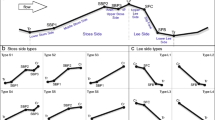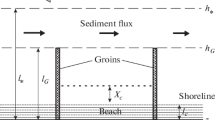Abstract
Applying a two-dimensional, non-linear hydrodynamic numerical model in combination with a semiempirical equation for bedload sediment transport, the influence of geometry on the formation of sandbanks is investigated. In the first experiment, the formation of sandbanks in an ideal rectangular basin, resembling the Taylor’s problem, was calculated. Sandbanks occur in a small area at the closed boundary. Similar experiments were carried out for a range of wavelengths of the incident Kelvin wave. The results reveal that large wavelengths favor the generation of sandbanks. In subsequent calculations, the basin was modified by introducing new geographical features like bays and peninsulas. The numerical experiments show that geometry is a fundamental factor to determine the position where groups of sandbanks appear. The results suggest that in regions where the Kelvin wave is diffracted, the formation of sandbanks occurs. An experiment, in which we applied an ideal geometric configuration representing that of the Southern Bight of the North Sea, generated sandbank patterns resembling those observed in the region.






Similar content being viewed by others
References
Boczar-Karakiewicz B, Bona JL (1986) Wave dominated shelves. A model of sand ridges formation by progressive infra-gravity waves. In: Knightand J, McLean R (eds) Shelf sands and sand stones, Memoir 11. Canadian Society of Petroleum Geologists, Calgary, pp 163–179
Brown PJ (1973) Kelvin wave reflection in a semi-infinite canal. J Mar Res 31:1–10
Carbajal N (1997) Two applications of Taylor’s problem solution for finite rectangular semi-enclosed basins. Cont Shelf Res 17:803–808
Carbajal N, Backhaus JO (1998) Simulation of tides, residual flow and energy budget in the Gulf of California. Oceanol Acta 21(43):429–445
Carbajal N, Montaño Y (1999) Growth rates and scales of sand banks in the Colorado River Delta. Ciencias Marinas 25(4):525–540
Carbajal N, Montaño Y (2001) Comparison between predicted and observed physical features of sandbanks. Estuar Coast Shelf Sci 52:435–443
Clarke S, Elliott AJ (1998) Modelling suspended sediment concentration in the firth of forth. Estuar Coast Shelf Sci 47:235–250
Dyer KR, Huntley DA (1999) The origin, classification and modeling of sand banks and ridges. Cont Shelf Res 19:1285–1330
Fang Z, Yee A, Fang G (1991) Solutions of tidal motions in a semi-enclosed rectangular gulf with open boundary conditions specified. In: Parker BB (eds) Tidal hydrodynamics. Wiley, New York
Gomez-Rivera J (2003) El problema de Taylor y el transporte de sedimentos. Thesis, University of San Luis Potosí
Hulscher SJMH (1995) Tidal induced large-scale regular bed form patterns in a three-dimensional shallow water model. Institute for Marine and Atmospheric Research, Utrecht, R 95-11
Hulscher SJMH, de Swart H, de Vriend HJ (1993) The generation of offshoretidal sand banks and sand waves. Cont Shelf Res 13(11):1183–1204
Huthnance JM (1982) On the mechanism forming linear sand banks. Estuar Coast Shelf Sci 14:79–99
Montaño Y (2003) Long term effects of the bed-load sediment transport on the sea-bottom morphodynamics of the Colorado River Delta. PhD Thesis, University of Liege
Mulder T (2002) Modelling patterns of large-scale morphodynamical change in the Southern Bight of the North Sea. Institute for Marine and Atmospheric Research, Utrecht, V 02-07
Núñez-Riboni ID (2002) Dinámica y procesos dispersivos en el complejo lagunar Bahía de Altata-Ensenada del Pabellón, Sinaloa. Thesis, Instituto de Ciencias del Mar y Limnología, UNAM, 93 pp
Off T (1963) Rhythmic linear sand bodies caused by tidal currents. Bull Am Assoc Petrol Geol 47:324–341
Pattiaratchi C, Collins M (1987) Mechanisms for linear sandbank formations and maintenance in relation to dynamical oceanographical observations. Progr Oceanogr 19:117–156
Pattiaratchi C, Harris PT (2002) Hydrodynamic and sand-transport control in an echelon sandbank formation: an example from Moreton Bay, eastern Australia. Mar Freshwater Res 53:1101–1113
Roos PC, Hulscher SJMH (2002) Formation of offshore tidal sand banks triggered by a gasmined bed subsidence. Cont Shelf Res 22:2807–2818
Signell RP, Harris CK (1999) Modeling sand bank formation around tidal headlands. In: Sixth international conference on estuarine and coastal modeling, 3–5 November, 1999
Taylor GI (1921) Tidal oscillations in gulfs and rectangular basins. Proc Lond Math Soc 20:148–181
Van de Meene JWH, van Rijn LC (2000a) The shoreface-connected ridges along the central Dutch coast—part1: field observations. Cont Shelf Res 20:2295–2323
Van de Meene JWH, van Rijn LC (2000b) The shoreface-connected ridges along the central Dutch coast—part2: morphological modeling. Cont Shelf Res 20:2325–2345
Van der Molen J, Gerrits J, de Swart HE (2004) Modelling the morphodynamics of a tidal shelf sea. Cont Shelf Res 24:483–507
Walgreen M (1999) A model study on the formation of shoreface-connected sand ridges. Institute for Marine and Atmospheric Research, Utrecht, V 99-3
Zhu Y, Chang R (2000) Preliminary study of the dynamic origin of the distribution pattern of bottom sediments on the continental shelves of the Bohai Sea, Yellow Sea and East China Sea. Estuar Coast Shelf Sci 51:663–680
Zongwan X, Carbajal N, Sündermann J (1995) Tidal current amphidromic system in semi-enclosed basins. Cont Shelf Res 15(2/3):219–240
Acknowledgements
This research work was funded by Consejo Nacional de Ciencia y Tecnología, CONACYT, through the project 36895-T. Thanks are due to Dr. Yovani Montaño for his valuable comments.
Author information
Authors and Affiliations
Corresponding author
Additional information
Responsible Editor: Paulo Salles
Rights and permissions
About this article
Cite this article
Carbajal, N., Piney, S. & Rivera, J.G. A numerical study on the influence of geometry on the formation of sandbanks. Ocean Dynamics 55, 559–568 (2005). https://doi.org/10.1007/s10236-005-0034-1
Received:
Accepted:
Published:
Issue Date:
DOI: https://doi.org/10.1007/s10236-005-0034-1




